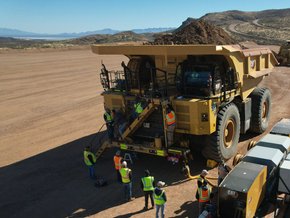Industry Q&A: Mining Data Management, Analysis and Integrity

Data management and analysis is a huge part of mining operations around the globe today and its potential to improve productivity and drive down cost is significant.
In 2014, companies such as Rio Tinto, FMGL and BHP Billiton all came out saying they'd saved hundreds of millions of dollars through smart data usage. Austmine caught up with David Stephen, Managing Director of acQuire Technology Solutions to get his insights into why more companies aren't seeing these kinds of results, and his strategies for using mining operations data to drive better results.

What are the biggest challenges for mining companies nowadays with data management and analysis?
The challenges with data management and analysis are the same challenges faced in other areas of the industry – transient workforce, shortage of professional skilled workers, risk management, governance, and scale. How they manifest themselves from an information management standpoint isn’t always clearly understood, though.
• The Potential of 'Big Data' in Mining
• [VIDEO] Rio Tinto Unveils Mine of the Future, Hints at Big Data Optimization
From a geoscience perspective - geologists are really good at collecting data. That data is vital to decision-making at the business level, not just at the drill hole. But geologists don’t always have the right tools to manage the data. Often there will be multiple copies of the same data, different departments will be updating data in silos, or data gets corrupted and it’s hard to know why or where. Geoscientific data is expensive to collect and it’s hard to manage. The biggest challenge is there’s often no central repository - no single source of truth - when it comes to geoscientific data, but that’s exactly what a business needs for effective reporting and decision-making.
How important is it for mining companies to be able to cross reference data from different departments within the operation? What tangible benefits does this allow to the business?
It’s becoming more important than ever. From an operations perspective, you have minimized disruptions, increased efficiencies and better use of resources.
As I mentioned before, once an organization can rely on a single source of truth for their data, reporting becomes more effective. It’s much easier to see the total cost of an operation, even down to the drill hole. Forecasting improves and the people running the business operate with a greater degree of confidence. Managers have an increased knowledge and understanding of exposure to risk. And it’s not just the mine managers and superintendents benefitting. People on the board and at the executive level are more effective in their strategic planning activities.
From a bigger picture vantage point, shareholder value is enhanced because you can minimise losses and maximize opportunities based on credible, durable data assets.
Where are the biggest risks to data integrity in a mining operation? Is it possible for miners to minimize, or even completely eradicate, any of these?
There are two things we work to minimize: storing bad data and corrupting data that’s already been stored. Some of it can be attributed to human error. Different systems or software at different locations can make it difficult to share data or understand workflows. Teams distributed across different mine sites can find it hard to share data. And, what seemed correct in the field doesn’t always hold up once you’re in the office and vice versa. How data is collected, stored, and reported may be subtly different from site to site, and that’s enough to create big headaches at the corporate level.
When your data is unreliable, you’re also exposed to increased risk, especially from outside review. Data integrity provides a stronger culture around risk management and contributes to quality-focused organizational goals.
It’s easy to consider the present or the next financial year, but when you’re a miner in the nuclear industry or working with environmental pressures, data integrity is essential for years into the future - decades or even centuries from now.
2015 looks to be another year where the big focus is on improving productivity levels. How can a better data management system help drive productivity in mining operations?
Everyone we talk to is tightening belts and trying to accomplish more with fewer resources. It’s a fact of life in the natural resources industry when commodity prices are on the downturn. But to a certain extent, geoscientific information management (GIM) is always addressing productivity challenges.
If you think about it, being in control of the quality and integrity of your data is one of the most important productivity measures you can take. If you can rely on your internal systems and processes and not specific personalities to manage your geoscientific information, your organization is in better shape from a productivity standpoint but also in relation to governance.
Specifically, a good data management system allows your geoscientific data to become a long-lasting asset to your business. Regardless of staffing issues, budgeting or government regulation, once you have credible data stored in a central place that everyone in your organization can view; you’re already winning the productivity game. You have a better understanding of how to control costs. Geologists can get back to geology and quit having to fiddle with data. I’ve yet to meet one of those guys who are happy after a day trying to make spreadsheets talk to each other or figure out how their sample data got corrupted. And once a team can understand workflows and what comes next, it really improves.
So, yes, 2015 is going to be another year with a productivity focus but that’s pretty much the space acQuire operates in regardless.
Why is it crucial for mining companies to have an overall strategy to manage their geoscientific data?
I alluded to this earlier, but data is vital to decision support and strategic decision-making within an organization. The more reliable your data, the more nimble your decision-making becomes. Without a strategic view of how that data is going to be managed across an organization, competitive advantage is diluted.
High-quality geoscientific data is where the long-term value is in a mining operation. What amazes me is how often geoscientific information management is done on an ad-hoc basis or develops in an organic way over a period of time. As someone coming from a financial background, it would be unthinkable to address your bookkeeping and accounting in that way but, unfortunately, it’s not uncommon with data.
What other parts of the business benefit from a strategic view of data management and analysis?
One of the things I love about speaking to our customers is we always find new ways people are using our products. For example, Anglo American realized the application was far bigger than with the geology team. Several different areas appreciate having data assets they can rely on, including engineering and marketing. They capture all sorts of peripheral data using the GIM Solution including all exploration costs, so they have extremely accurate figures of the total cost of a borehole. They also have a much better sense of how long it takes to process approvals and are using it to effectively track and allocate time against projects.
Once you have a strategic view of your data management, you can use it to assist with corporate performance and risk management. The risks and outcomes associated with GIM may warrant its inclusion in the Corporate Risk Management framework, and a clear corporate policy will help position GIM as appropriate in terms of both organizational and operational priority.
In other words, effective data management supports an organization’s objective to maintain a complete record of quality, error-free geoscientific data in a single, secure, safe and managed location. It also shows your information is managed to your data security policy. Importantly, a GIM strategy ensures contractors and consultants have access to the data they require as outlined by your data management policies and procedures. That’s really hard to do with a spreadsheet.
Article was previously posted on Austmine.com.au
- Brightstar, Eldridge and Claure acquire AusencoSupply Chain & Operations
- First Quantum contracts with MECS to cut emissionsSupply Chain & Operations
- Tin production at Andrada Mining reaches record levelsSupply Chain & Operations
- Ternium plans to build US$3.2bn steel plant in MexicoSupply Chain & Operations






